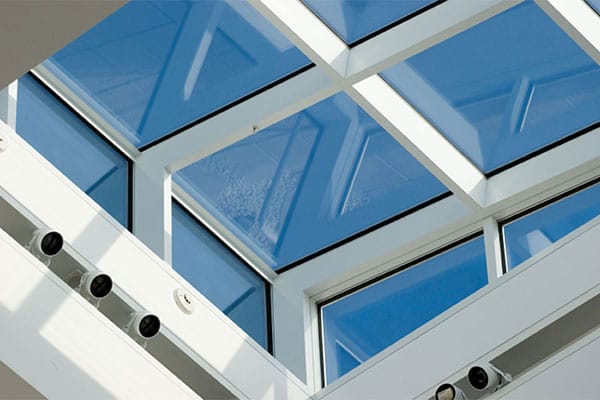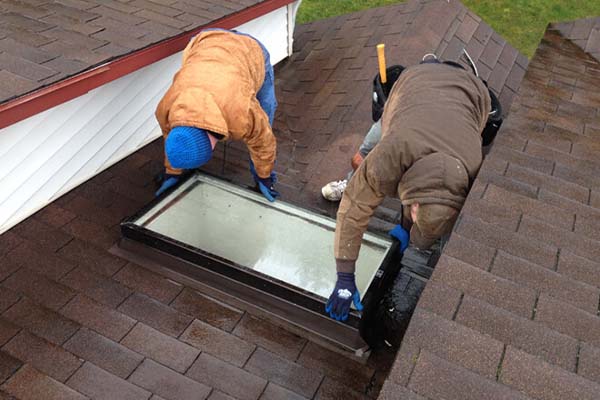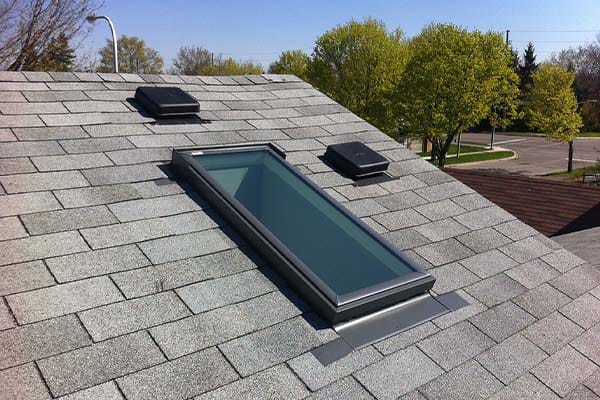

Most days you barely register a good skylight; the room feels open, the mood lifts, and you just get on with your life. You do notice a bad one. A faint tea stain creeps across the plaster around the reveal, the glass fogs from within no matter how hard you polish, or a winter draught finds its way down the back of your neck whenever the wind swings round. If you’re wondering when to replace skylight units or whether a careful repair would buy a few more years this guide lays out the way professionals think about the problem so homeowners, renovators and roofing contractors can make the same steady decisions.
Replacement is rarely the first step. A little routine care delays it by seasons, sometimes by years. When gutters and valleys are cleared, when the upstand on a flat roof can still shed water away from the glass edge, and when seals and gaskets are checked before they crack under UV, a skylight tends to behave itself. Cleaning helps more than most people expect. Dirt diffuses daylight, mineral spots bake onto the outer pane in summer, and both give the impression of a failed unit long before anything is truly wrong. A gentle rinse, a pH-neutral wash and a second rinse finished with a soft dry usually restore the brightness that made you choose the opening in the first place.
Maintenance also protects the numbers on the brochure. Low-E coatings, warm-edge spacers and gas fills only deliver their promised skylight energy efficiency if the frame is tight to the vapour control layer and the interior reveal isn’t acting as a cold bridge. A modest re-seal or a small patch of insulation at the reveal can change the feel of a space far more than replacing glass that isn’t actually faulty. That said, there are limits. Once certain symptoms appear and persist after sensible checks the conversation turns from maintenance to replace skylight with a clear conscience.
The tell-tales that contractors treat seriously aren’t dramatic; they’re stubborn.

Condensation inside the panes
Condensation that sits on the inner face after a shower is not a failure; condensation trapped inside the cavity between panes is. You can wipe the first away. You cannot reach the second at all, because the edge seal of the insulated glass unit has given up and the desiccant is saturated. From that point on, the unit has lost a chunk of its thermal performance and will mist whenever conditions suit. In many modern rooflights the glass can be changed; on older models a full unit swap is often the cleanest path.
Persistent water leaks
Water that returns to the same place after every heavy spell is another honest messenger. If you have checked the obvious compatible flashing for the actual tile or slate profile, intact laps to the membrane, a sound upstand on flat roofs and the stain still reappears, the geometry or the frame has reached the end of its dependable life. Equally, movement you can feel with the back of your hand, especially along the hinge line of an opener, suggests the airtight line has been breached. You can sometimes improve the situation with gaskets and adjustments, but if the structure has warped or the hardware is simply worn out, you are paying labour to delay the inevitable.
Glass cracks and defects
Glass defects belong in their own category. A crack from impact, a chip that has weakened a corner where the sash closes, or the rare but real spontaneous breakage of toughened glass are not problems to park. Laminated inner panes often keep everything in place and safe, which is exactly what they are designed to do, yet the barrier has still lost its integrity and should be renewed promptly. Finally, the quietest warning sign of all is the absence of support: if spares are discontinued and the manufacturer no longer provides service instructions, you have to ask whether you want to invest in a patch you can’t repeat next year.
Read more: Top Skylight Maintenance Tips for Longevity
There is no single expiry date because roofs, exposures and specifications vary. As a guide, pitched roof windows with decent care often reach two or three decades before they demand a big decision. Flat rooflights can do similar numbers if the upstand is well built, the waterproofing is detailed correctly and water isn’t allowed to sit against the glass edge; where those details are poor, lifespans are shorter.
The glass unit itself is usually the limiting component. Many IGUs perform happily for fifteen to twenty years; after that the odds of edge-seal fatigue climb, especially on south and west pitches that live with stronger sun and higher daily temperature swings. Moving parts hinges, chains, actuators have shorter service lives and are the parts most likely to give you a nudge toward replacement when the building is otherwise doing fine.
The lifespan of a skylight depends on several key factors, from the environment it faces to the way it’s installed and maintained.

Environment
Installation quality
Specification of materials
Access and maintenance
What’s the smartest choice of material for a long-lasting skylight? Read Best Material for Skylights to find out.
A calm diagnosis beats assumptions every time. If a single joint in the perimeter sealant has failed while the flashing and the upstand remain true, raking out and renewing that joint with a compatible product is a good use of money. If a manual opener feels stiff because dust has built up along the tracks, a clean and a careful lubrication can restore the movement you remember. A motor that refuses to close in light rain sometimes needs nothing more than a new sensor. In other words, where the fault is local and the rest of the assembly is young and supported, repair first.
Replacement wins when the architecture or the user experience is wrong and no sensible patch can change it. Chronic overheating on a south-facing pitch with a high g-value glass, persistent glare over a kitchen island because the opening was dropped in the wrong part of the plan, or a draught that returns because the air barrier was never designed properly are all signs that a fresh unit, correctly specified and detailed, will deliver a cleaner, cheaper result over the next decade than a cycle of fixes.
A blown IGU on a dated model can sometimes be swapped; if the sash isn’t designed for that, and if scaffolding or access gear will be needed twice, the arithmetic quickly favours replacement. There are also safety-critical cases walk-on glass with edge delamination, smoke-vent (AOV) units that form part of a fire strategy where professional advice is essential and replacement may be the responsible choice even if a patch looks tempting.

Choosing and buying from the best skylight brands can reduce the need for repairs and replacements.
Budgets are shaped by more than the ticket price of the unit. The simplest projects are like-for-like swaps at reachable heights, where the existing aperture is sound and the plasterboard returns only need a light make-good. As soon as you change type fixed to opening, double to triple glazing, conservation pattern to a flush modern unit costs shift because the flashing, the electrics or the interior finish need new work.
Access is often the largest hidden line. One rooflight on a third-storey elevation may demand scaffolding or a small crane; bundling two or three replacements into the same visit is how contractors keep overall spend sensible. Time matters too: an installer who can open and close within the day keeps the weather outside and the budget under control.
Where comfort is part of the brief, consider upgrades at the same time. A laminated inner pane to lift the interior surface temperature, a solar-control coating on south and west pitches to keep summer in check, or an automated opener with a rain sensor and a simple wall switch often cost less in the round than retrofitting later.
The least expensive path is rarely the cheapest over the life of the building. If you keep the aperture the same, reuse the structural trimming and choose a specification that solves the problem you actually have, you tend to spend once rather than twice.
ou should replace a skylight when two conditions align: clear signs of failure (such as mist between panes, repeated leaks, cracked or warped frames, or unsupported parts) and the skylight being old enough that repairs would only be temporary. If only one condition applies, try simple fixes like cleaning, resealing, or checking flashing and ventilation. But when both apply, replacement is the right choice—and a chance to upgrade the specification for longer, quieter performance in the years ahead.
Replacing a skylight doesn’t have to be guesswork—by following a clear, step-by-step plan you can make the right decision at the right time.
Start with evidence. Take photographs of the interior and exterior, close and wide, on a dry day and after rain. Note the orientation and any nearby trees, chimneys or plant that might cast shade or drop debris. If the complaint is fogging, confirm whether it is on a surface you can touch or inside the glass.
If the complaint is a stain, track its shape; brown arcs at the top corner point to a very different cause than a shadow that creeps up from the sill.
Share that evidence with a contractor or manufacturer and ask for whole-window performance data not just centre-pane numbers if you move towards a replacement.
Then make a decision about comfort. If overheating or glare drove you mad before, choose a g-value and a blind you will actually use; if winter chill spoiled a sitting area, lift the Uw and specify a laminated inner pane for a warmer interior surface.
Finally, plan access once and do the work cleanly. A small amount of organisation ordering the right flashing for the exact tile, allowing time for airtight tapes and insulated reveals, scheduling the plasterer for the next day keeps the roof open for the shortest possible window.
Replace too early and you waste a perfectly good unit; replace too late and you pay twice in damaged finishes and frustration. Pay attention to what the skylight is telling you, consider where it sits on its life curve, and be honest about whether you want to live with the current comfort level for another winter. That is the real test of when to replace skylight units, and it is the test homeowners, renovators and roofing contractors return to when they want to stop firefighting and get back to enjoying the light.


Send us your contact details and a specialist will get in touch with you.